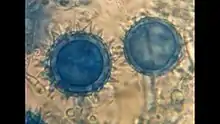| Pythium oligandrum | |
|---|---|
 | |
| Pythium oligandrum | |
| Scientific classification | |
| Domain: | Eukaryota |
| Clade: | Diaphoretickes |
| Clade: | SAR |
| Clade: | Stramenopiles |
| Phylum: | Oomycota |
| Order: | Peronosporales |
| Family: | Pythiaceae |
| Genus: | Pythium |
| Species: | P. oligandrum |
| Binomial name | |
| Pythium oligandrum Dreschler | |
Pythium oligandrum is an oomycete. It is a parasite of many fungi and other oomycetes including Botrytis, Fusarium and Phytophthora. It has been licensed[1] as a biocontrol agent in the form of an oospore soil treatment, which reduces pathogen load and concomitant plant disease. P. oligandrum have been found to express several genes belonging to the CAZy-family when feeding on prey.[2] P. oligandrum can grow within the roots of certain plants, including tomato and sugar beet. Production of auxin-like substances stimulate plant growth. Defense responses can be induced in the plant, which primes the plant from further infection by pathogenic fungi, oomycetes or bacteria.
Toxicology
UC IPM provides an automated tool to evaluate the ecotoxicology risk of the use of P. oligandrum.[3]
References
- ↑ Plato Roberts, Amy. "Biopesticides Fact Sheet" (PDF). epa.gov. Retrieved 10 February 2018.
- ↑
- Bělonožníková, Kateřina; Hýsková, Veronika; Chmelík, Josef; Kavan, Daniel; Čeřovská, Noemi; Ryšlavá, Helena (2022). "Pythium oligandrum in plant protection and growth promotion: Secretion of hydrolytic enzymes, elicitors and tryptamine as auxin precursor". Microbiological Research. Elsevier. 258: 126976. doi:10.1016/j.micres.2022.126976. ISSN 0944-5013. PMID 35158298. S2CID 246687321.
- Hashemi, Maryam; Tabet, Dania; Sandroni, Murilo; Benavent-Celma, Clara; Seematti, Jenifer; Andersen, Christian B.; Grenville-Briggs, Laura J. (2022). "The hunt for sustainable biocontrol of oomycete plant pathogens, a case study of Phytophthora infestans". Fungal Biology Reviews. British Mycological Society (Elsevier). 40: 53–69. doi:10.1016/j.fbr.2021.11.003. ISSN 1749-4613. S2CID 244889249.
- Liang, Dong; Andersen, Christian Benjamin; Vetukuri, Ramesh R.; Dou, Daolong; Grenville-Briggs, Laura J. (29 October 2020). "Horizontal Gene Transfer and Tandem Duplication Shape the Unique CAZyme Complement of the Mycoparasitic Oomycetes Pythium oligandrum and Pythium periplocum". Frontiers in Microbiology. Frontiers. 11. doi:10.3389/fmicb.2020.581698. PMC 7720654. PMID 33329445. S2CID 225097281.
- ↑ "UCIPM WaterTox - Pesticide Risks to Water Quality - Active ingredient: Pythium oligandrum DV 74 (ATCC 38472) (A Filamentous Fungus)". UC Integrated Pest Management (UC IPM). UC Agriculture (UC ANR).
- Brožová, J. Exploitation of the mycoparasitic fungus Pythium oligandrum in plant protection. Plant Protection Science. 38:29-35 (2002)
- Picard,K., Tirilly,Y. and Benhamou,N. (2000) Cytological effects of cellulases in the parasitism of Phytophthora parasitica by Pythium oligandrum. Appl.Environ.Microbiol., 66, 4305-4314.
- Le Floch,G., Rey,P., Benizri,E., Benhamou,N. and Tirilly,Y. (2003) Impact of auxin-compounds produced by the antagonistic fungus Pythium oligandrum or the minor pathogen Pythium group F on plant growth. Plant Soil, 257, 459-470.